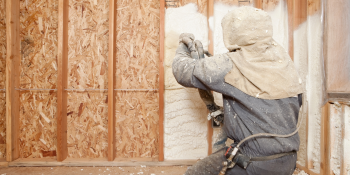Q&A Forums
air circulation in closed system Post New Topic | Post Reply
| Author | Comments |
|---|---|
|
chris saunders
Posted: Jul 30, 2008 10:27 PM
|
air circulation in closed system
first, hopefully only posy. once high density foam is applied to walls,roof deck and basement cavity, how does one keep air circulating throughout the house. i've heard conflicting stories and need a positive answer. thank you, guys. chris
|
|
Rob Granger
Posted: Jul 31, 2008 07:13 AM
|
CS, Once you spray foam a house it will be to tight and a house needs a certain amount of air exchange to provide good indoor air quality hence an ERV or an HRV will need to be added. See if you can find a "Building Performance Institute" certified home performance tech, they are trained to evaluate and reccommend the amount of ventilation you will need. Most heating/cooling techs do not have enough training to make the recommendation. You also could check with your state energy office; I am sure they will be able to help. I speak to you as a BPI.org trained proffessional, a nationally recognized program. YES FOAM |
|
Dan Beecher
Posted: Jul 31, 2008 09:36 AM
|
Adding to what yes said, try to find and work with a local mechanical contractor that understands foam. My mechanical guy did a lot of research before we decided what we should put in my house. You will in most cases be able to downsize your heating and cooling systems. This will prevent short cycling of your systems and make your house more comfortable too. I also have the fans run on my system 24/7. This prevents any "dead spots" of no circulation. I also run my air exchanger 20 min on 40 off in the winter to bring in fresh air. I heat 4000 sq ft in North Dakota for $150 a month in the winter. 3" in the walls 5" in the ceilings of closed cell. |
|
Jim Coler
Posted: Aug 11, 2008 03:44 PM
|
An HRV is one answer, but in many cases even the BPI program recognizes a properly sized bathroom fan on a timer or Humidistat as a mechanical air exchange system. A bathroom fan draws moist air out of the house and small amounts come in around your doors and windows. (no door or window seals perfectly). Some also use an outside air intake on their cold air return ductwork with a humidistat controled damper on it, but this is the pressurization approach which can drive moist air to cold surfaces and cause condensation - leading to mold/mildew. Just stating there are other options out there that are recognized - as a BPI contractor myself! |
|
chris saunders
Posted: Aug 11, 2008 03:59 PM
|
thanks for all your input. i have purchased a 220 CFM fan vented from both bathrooms and out thru the roof. The auditor seemed to think this would be sufficient. Hi- efficiency furnace, on demand water system and gas fireplace all pull their air from outside. Any other input is appreciated. Chris |
|
Jim Coler
Posted: Aug 12, 2008 08:52 AM
|
The first indication of more air circulation needed is typically condensation on the the bottom edges of the northern side windows. If you're getting condensation, increase air cirulation. Sometimes just from room to room is enough. This also assumes that you've done everything you can to prevent other sources of moisture from entering the building - like basement floor and walls, downspouts drained far away, etc. Best of luck. |
|
Ronnie natal
Posted: Aug 25, 2008 12:10 AM
|
I sprayed my brothers house with 1# in the walls and .5 lb in the roof. The roof is sealed and he downsized his unit, but he still has high humidity in his attic. My sullpier suggested he install a damper in his return air intake in the attic to remove the stale air. My brother doesn't think that is the coorect fix, so he complains to me. I need the correct answer to make him happy and so that I know what to suggest in a closed envelope system. I would think the damper is the answer. |
|
Rob Granger
Posted: Aug 25, 2008 05:25 PM
|
SFI, Excess moisture is excess moisture and that is a problem that must be fixed... You must look for the cause and correct that not just remove the symptom(moisture)! Does the house have a stove exhaust hood vented to the outside? It should have! Does each bathroom have an exhaust fan vented to the outside? It should have! And then the question becomes are they used each and every time moisture is generated within the house? 2nd-How tight is the house? The only way to know is if a blower door test is conducted by a trained professional. I would guess that the house is too tight and that an ERV or HRV needs to be added to bring fresh air into the house for exchange.... AND...You can't expel moisture using a fan/vent if the house is too tight! remember, you can only vent/push air out if an equal amount comes in to the house!! If you would like to call me I can help you to some degree over the phone. YES FOAM 1-716-801-5100 anytime |
|
Mike Natal
Posted: Sep 23, 2008 03:52 PM
|
Dear Yes, I'm Southern Foam Insulations brother. Let me give you more info to help you answer the question. 1)I have exquast fans in all bathrooms venting outside. 2)My cook top hood is vented directly outside. My moisture.humidity/mold problems do not exist in my home living space that is air conditioned.That relative humidity is aroud 45 to 50% which is inside the normal range. Keep in mind I live in Louisiana where the outside air is humid as heck. I also live on the water where theres a brisk wind most of the time. My problem lies in my attic! Thats where the moisture and mold is. The humidity is on averge 75 to 82% in my attic at any given time. My air conditioned space is about 3000SF. I have two three ton heat pumps, one for the bedroom areas and the other for theliving and kitchen areas. My main question is, what different items should my AC man have done to the inside air handlers since I enclosed my rafters and walls with open cell spray foam vs normal batt insulation?? He did down size mt units by the way. I told my brother I need a thicker per inch average and the attic needs to be completely enclosed are the air seeping in will cause all metal items to draw the moisture to them and sweating will occur all over. I did a negative air test which verified what I just said. What is the main solutin to the air thats in the attic? I was told no to fresh air or make up air being brought in from outside. I was told no to air conditioning my attic. What is the correct thing to do different to the air handlers in the attic with the rafters haveing the foam? Thanks, Mike N |
|
Posted: Sep 24, 2008 07:44 AM
|
Just an observation. We work with climates very close to your Louisiana typical weather. If you have 3000 sq. ft. of heated space, and you have foam installed properly, you don't need 6 tons of air conditioning. The system will not run long enough to remove the humidity. And the short cycling will provide a much higher bill than you could expect with a properly sized unit. If he downsized to get to 6 tons in a 3000 sq. ft. area with foam, this could be a large portion of your problem. Down sizing properly, using a dual stage system, air exchange as needed and humidistats will help. Just my 2 cents. Good Luck. Talon |
|
Jim Coler
Posted: Sep 24, 2008 08:52 AM
|
It sounds like this is a metal truss type of attic? Am I correct? If so, these may need to be insulated further down each penetration to minimize the thermal bridging and condensation issues. It also sound like there are still gaps around some areas which is allowing outside air into the attic? If the attic is sealed well and you have minimzed the thermal bridging, then you should be able to control the RH in that space and not have mold issues. Another questions, is where is the mold occuring? In order for mold to occur, you need to have a food source and moisture and oxygen. Like YES said, where is the moisture coming from? Is your basement damp? Where is the condensation occuring? On what surface and what is the temperature of that surface? Typically, we find that a basement or crawlspace is the root cause of moisture/mold issues along with air movement through the building. If you prevent excess moisture from coming in the building, then you can control the RH. If you don't control what's coming in, then you'll likely lose control of the RH inside. |
|
Greg Pruitt
Posted: Sep 25, 2008 11:02 AM
|
We do alot of homes in high humidity. you should have approx. 40% less tonage, sometimes as much as 50% less. This is your problem. I wuld extimate on your 300 sq foot huse, you need about 3.5 tons. YOu are not going to fix the problem with this much tonage and you are wasting energy. Foam is ony hlf of the equasion. Hvac is the other 50% of the answer. do just one, and you have the problem you describe. In an instance where occasionally youmight need to have more toaage,...Party, then you install 2 stage compressors, and variable speed fans. Hope this khelps, but this one I would bet on! |
|
Greg Pruitt
Posted: Sep 25, 2008 11:13 AM
|
We have done many homes, and very few have erv's. In normal homes with about 4 people in them, and the windows are not fixed, in other words, tey open and close, you have enough air exchange. If you wnat, there is a cheap alternative, called ventilation on demand. You will probably never use it. |





























